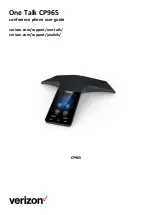
115
Federal Communications
Commission (FCC) RF Safety
Program
(http://www.fcc.gov/cgb/cellular.html)
International Commission on
Nonlonizing Radiation Protection
(http://www.icnirp.de)
World Health Organization (WHO)
International EMF Project
(http://www.who.int/emf)
Health Protection Agency
(http://www.hpa.org.uk/)
10 Driver Safety Tips
Your wireless phone gives you the
powerful ability to communicate by
voice almost anywhere, anytime. An
important responsibility accompanies
the benefits of wireless phones, one
that every user must uphold.
When operating a car, driving is your
first responsibility. When using your
wireless phone behind the wheel of a
car, practice good common sense
and remember the following tips:
1. Get to know your wireless phone
and its features such as speed dial
and redial. Carefully read your
instruction manual and learn to take
advantage of valuable features
most phones offer, including
automatic redial and memory. Also,
work to memorize the phone
keypad so you can use the speed
dial function without taking your
attention off the road.
2.When available, use a hands-free
device. A number of hands-free
wireless phone accessories are
readily available today. Whether you
choose an installed mounted device
for your wireless phone or a
speaker phone accessory, take
advantage of these devices if
available to you.
3.Make sure you place your wireless
phone within easy reach and where
you can reach it without removing
your eyes from the road. If you get
an incoming call at an inconvenient
time, if possible, let your voicemail
answer it for you.
4.Suspend conversations during
hazardous driving conditions or
situations. Let the person you are
speaking with know you are driving;
if necessary, suspend the call in
heavy traffic or hazardous weather
conditions. Rain, sleet, snow, and
ice can be hazardous, but so is
heavy traffic. As a driver, your first
responsibility is to pay attention to
the road.
5.Don’t take notes or look up phone
numbers while driving. If you are
reading an address book or
business card, or writing a “to-do”
list while driving a car, you are not
watching where you are going. It is
common sense. Do not get caught
in a dangerous situation because
you are reading or writing and not
paying attention to the road or
nearby vehicles.
6.Dial sensibly and assess the traffic;
if possible, place calls when you are
not moving or before pulling into
traffic. Try to plan your calls before
you begin your trip or attempt to
coincide your calls with times you
Safety
US670_Eng_Ver1.1_110527.qxd 2011.5.27 2:7 PM Page 115
Содержание Optimus U US670
Страница 149: ...147 MEMO US670_Eng_Ver1 1_110527 qxd 2011 5 27 2 7 PM Page 147 ...
Страница 150: ...148 MEMO US670_Eng_Ver1 1_110527 qxd 2011 5 27 2 7 PM Page 148 ...
Страница 308: ...MEMO US670_Spa_Ver1 1_110527 qxd 2011 5 27 2 22 PM Page 158 ...
Страница 309: ...MEMO US670_Spa_Ver1 1_110527 qxd 2011 5 27 2 22 PM Page 159 ...
















































